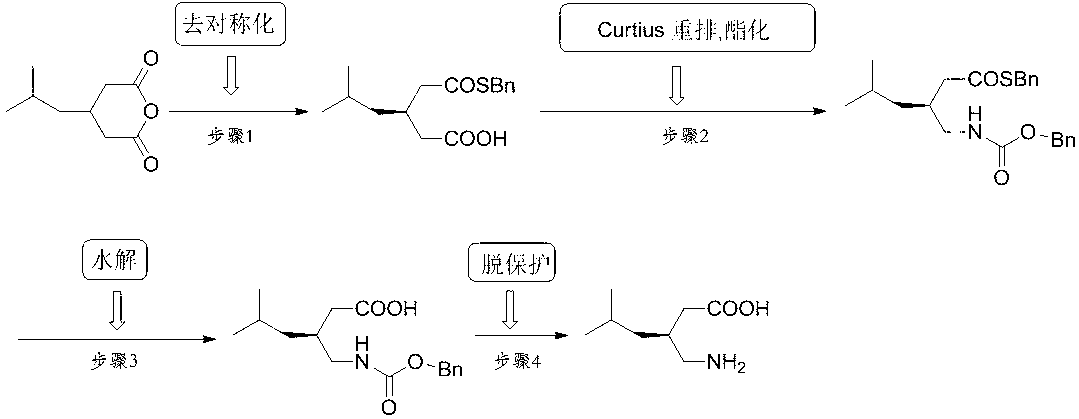Preparation method of pregabalin
A pregabalin and organic solvent technology, applied in the field of preparation of pregabalin, can solve the problems of expensive catalyst, high synthesis cost, low enantioselectivity, etc., and achieve simple operation, easy industrial production, and easy-to-obtain raw materials Effect
- Summary
- Abstract
- Description
- Claims
- Application Information
AI Technical Summary
Problems solved by technology
Method used
Image
Examples
Embodiment 1
[0038] Under nitrogen protection, 3-isobutylglutaric anhydride (1.70 g, 10 mmol), methyl tert-butyl ether (10 mL), (1R,2S)-1-(3,5-bis(trifluoromethane phenylsulfonyl)-N,N-dimethyl-1-(4-nitrophenyl)-3-(triphenylmethoxy)-2-propanamine (1.51 g, 2 mmol) in dry in the reaction vial. After stirring at room temperature for 10 minutes, it was cooled to 20 °C, and benzyl mercaptan (1.49 g, 12 mmol) was added dropwise, followed by TLC until the anhydride completely disappeared. The solvent was recovered under reduced pressure, the residue was dissolved in dichloromethane (10 mL), and extracted with saturated sodium carbonate solution (2×10 mL). The combined extracts were acidified to pH 1.0 with 2 N HCl and extracted with ethyl acetate (3×15 mL). The organic phases were combined, dried over anhydrous sodium sulfate, and the solvent was recovered under reduced pressure to obtain a colorless oil (2.80 g, 95%). [α] D 20 = +1.17 ( c =12, CHCl 3 ); 1 H NMR (400 MHz, CDCl 3 ): δ = 0...
Embodiment 2
[0040] Under nitrogen protection, 3-isobutylglutaric anhydride (1.70 g, 10 mmol), toluene (10 mL), (1S,2S)-2-(dimethylamino)-1-(4-nitrophenyl )-3-(trityloxy)propanol (0.96 g, 2 mmol) was placed in a dry reaction flask. After stirring at room temperature for 10 minutes, it was cooled to 0 °C, and benzyl mercaptan (1.49 g, 12 mmol) was added dropwise, followed by TLC until the anhydride completely disappeared. The solvent was recovered under reduced pressure, the residue was dissolved in dichloromethane (10 mL), and extracted with saturated sodium carbonate solution (2×10 mL). The combined extracts were acidified to pH 1.0 with 2 N HCl and extracted with ethyl acetate (3×15 mL). The organic phases were combined, dried over anhydrous sodium sulfate, and the solvent was recovered under reduced pressure to obtain a colorless oil (2.79 g, 94%). [α] D 20 = +1.19 ( c =12, CHCl 3 ); 1 H NMR (400 MHz, CDCl 3 ): δ = 0.77-0.83 (m, 6 H), 1.14 (t, J = 6.8 Hz, 2 H), 1.50 (sep, J ...
Embodiment 3
[0042] Under nitrogen protection, 3-isobutylglutaric anhydride (1.70 g, 10 mmol), methyl tert-butyl ether (10 mL), (1R,2S)-1-(3,5-bis(trifluoromethane Base) benzenesulfonyl)-N,N-methyl-1-(4-nitrophenyl)-3-(triphenylmethoxy)-2-propanamine (1.51 g, 2 mmol) placed in a dry in the reaction vial. After stirring at room temperature for 10 minutes, it was cooled to -20°C, and benzyl mercaptan (1.49 g, 12 mmol) was added dropwise, followed by TLC until the anhydride completely disappeared. The solvent was recovered under reduced pressure, the residue was dissolved in dichloromethane (10 mL), and extracted with saturated sodium carbonate solution (2×10 mL). The combined extracts were acidified to pH 1.0 with 2 N HCl and extracted with ethyl acetate (3×15 mL). The organic phases were combined, dried over anhydrous sodium sulfate, and the solvent was recovered under reduced pressure to obtain a colorless oil (2.82 g, 96%). [α] D 20 = +1.18 ( c =12, CHCl 3 ); 1 H NMR (400 MHz, CD...
PUM
 Login to View More
Login to View More Abstract
Description
Claims
Application Information
 Login to View More
Login to View More - R&D
- Intellectual Property
- Life Sciences
- Materials
- Tech Scout
- Unparalleled Data Quality
- Higher Quality Content
- 60% Fewer Hallucinations
Browse by: Latest US Patents, China's latest patents, Technical Efficacy Thesaurus, Application Domain, Technology Topic, Popular Technical Reports.
© 2025 PatSnap. All rights reserved.Legal|Privacy policy|Modern Slavery Act Transparency Statement|Sitemap|About US| Contact US: help@patsnap.com

